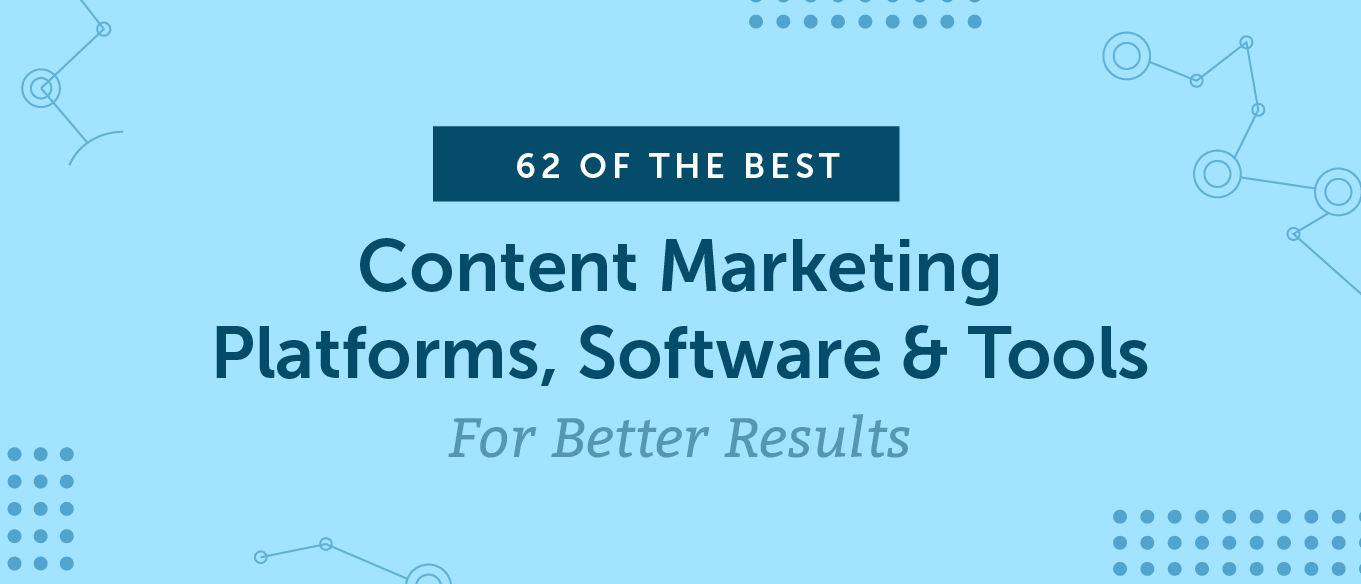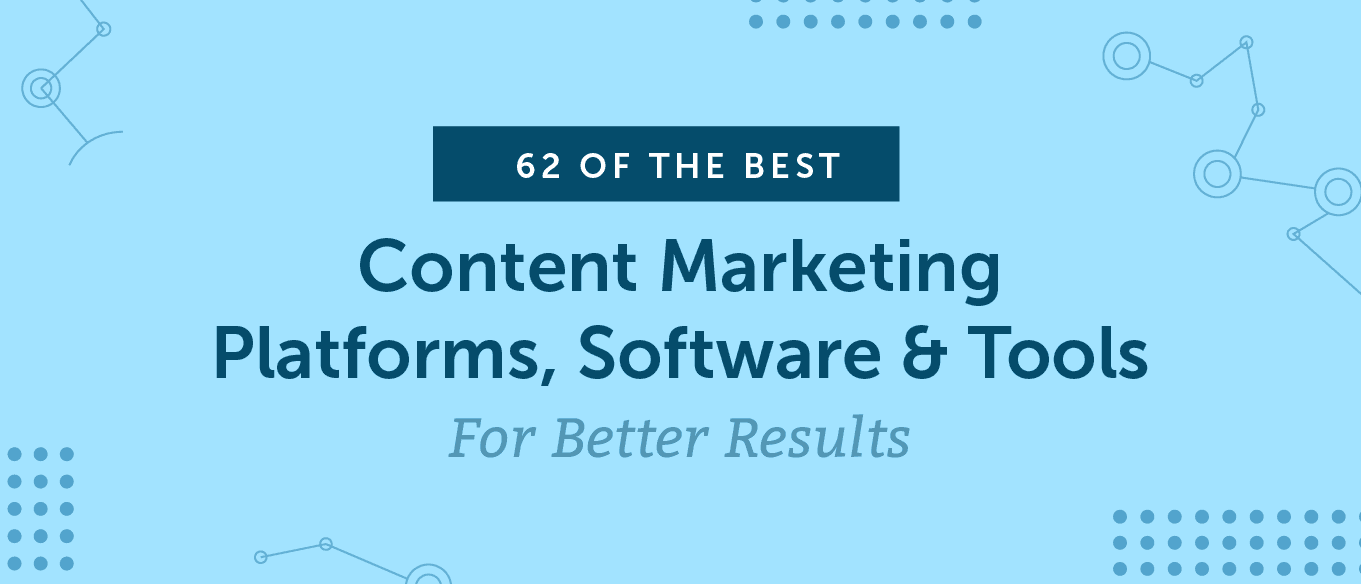
There are tons of content marketing platforms out there. Not to mention free content marketing tools and resources. For a marketer, keeping organized AND staying on top of the latest trends can feel nearly impossible.
So how can you give yourself the leading edge in content marketing?
The answer is actually pretty simple: By choosing the right tools and resources that will help you achieve better results.
In this post, we’ve brought together 62 of the best platforms, software, and tools in one place. All to help you decide which ones are the best fit for you. Consider this your catalog for a successful future.
Table of Contents:
1. What Is A Content Marketing Platform?
2. What Is Content Marketing Software?
Content Marketing Calendar Software
SEO Software
Social Media Software
Email Marketing Software
Video Marketing Software
Marketing Project and Work Management Software
Content Marketing Analytics Software
3. What Are Content Marketing Tools?
Free Content Marketing Tools
Content Writing Tools
Content Design Tools
Content Marketing Dashboard Tools
Content Marketing Research Tools
Content Curation Tools
4. Recommended Reading For Content Marketers
5. How To Convince Your Marketing Team To Adopt A New Platform
6. Get Organized With CoSchedule
1. What Is A Content Marketing Platform?
A content marketing platform is a robust, all-in-one suite that encompasses multiple functions into a single piece of software. You can typically accomplish many content marketing tasks with one of these platforms, from setting up workflows and creating content to managing analytics and driving ROI.
CoSchedule falls into this category as it gives you the ability to plan your marketing roadmap, manage team tasks, maintain content marketing, schedule social messages, and store assets in one place.
What Can You Do With a Content Marketing Platform?
Content marketing is much easier and more successful when you have one single hub to manage your team and projects. Here are just some of the things you can do with a content marketing platform:
Manage projects from start to finish.
Map content to an editorial calendar.
Create and publish content.
Promote that content through multiple channels.
Communicate on projects with team members.
Measure performance and analyze productivity.
This illustration from Curata outlines this more clearly:
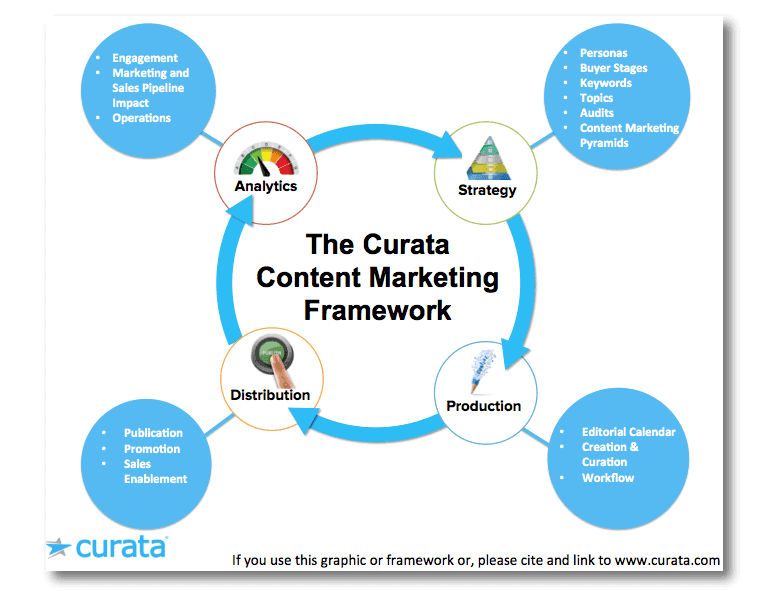
What Are Some Content Marketing Platforms?
Here are some options to consider:
CoSchedule: The only way to organize your all of your marketing functions in one place, do more in less time, and keep your team happy. This Gartner-recommended platform is the one place your marketing team goes to collaborate and execute all your marketing projects.
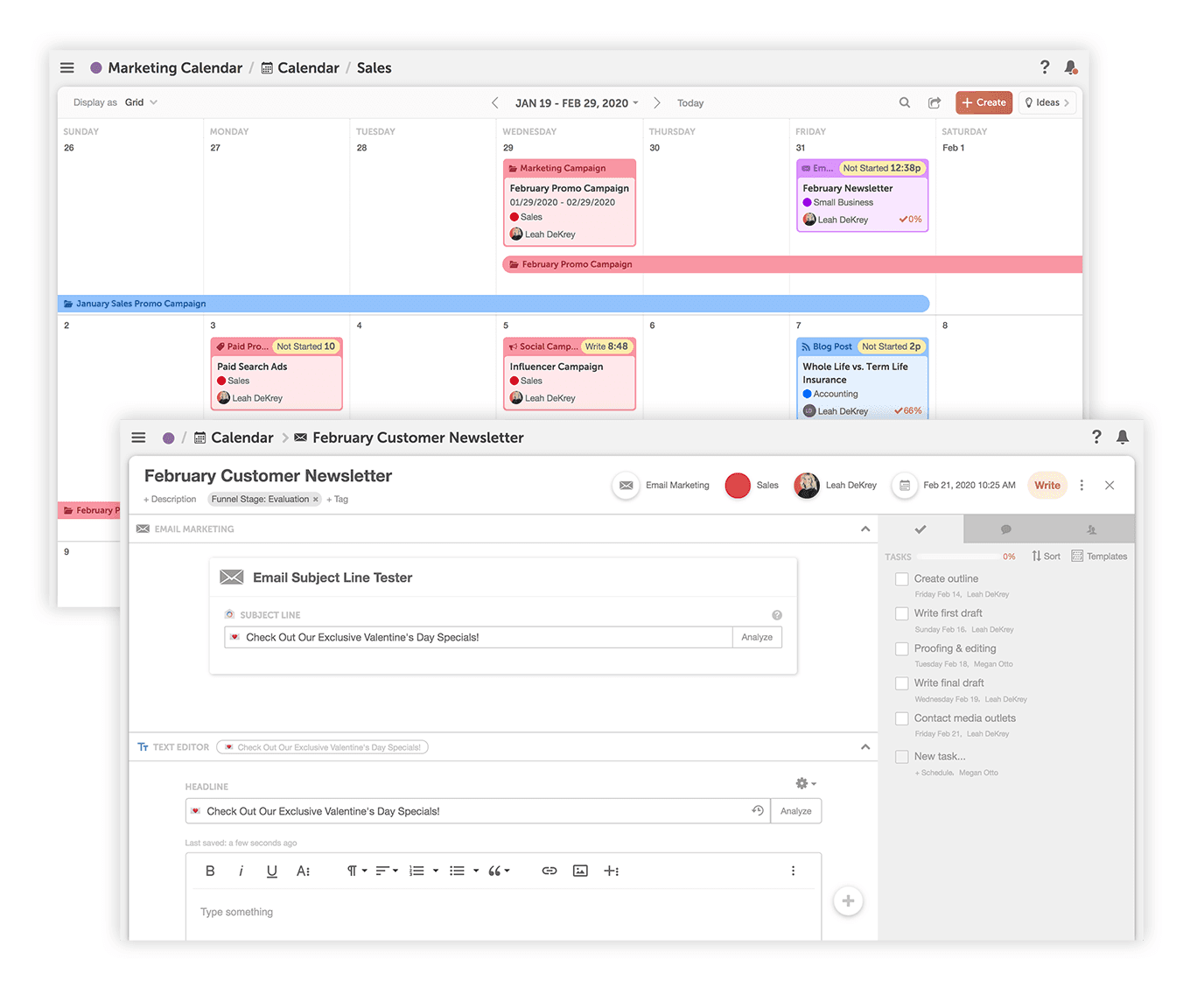
NewsCred: Works with large-scale brands.
Kapost: Focuses on serving enterprise-level B2B customers.
Percolate: Integrates with enterprise CMS and business intelligence platforms.
Contently: Brings freelancers and marketing teams together for content marketing purposes.
Curata: Makes content curation and freelance management easier.
2. What Is Content Marketing Software?
Content marketing software is an advanced, single-purpose app that helps marketers achieve a specific aspect of content marketing. That may include setting up a marketing calendar, scheduling a social media campaign, or managing team workflows.
Content Marketing Calendar Software
For marketers, content marketing calendars can make the difference between sinking in an unorganized workflow or successfully swimming in scheduled tasks.
What Can You Do With a Content Marketing Calendar?
If you’re not using a calendar already, this is likely your first question. The answers, though, are as numerous as the benefits to using them for getting organized.
Provide teams with one version of truth. When everyone knows what’s coming up ahead, and what they should be working on right now, teams function more efficiently and effectively.
Plan deadlines ahead of time. Overcome the fear of missing deadlines by mapping them out strategically.
Prevent last-minute fire drills. Coordinating projects on a clear calendar or timeline dramatically reduces the number of last-minute surprise projects that raise stress and derail productivity.
Here’s a visual breakdown behind the what, why, and how of managing marketing with a calendar:

What Are Some Different Content Marketing Calendars?
From Office templates to full-blown apps, you have plenty of options.
CoSchedule: Maybe you don’t need the full-blown marketing suite offered by CoSchedule and are really just looking for a great marketing/editorial calendar. Where you can create and manage a single publishing calendar that serves as the blueprint for your content, social, email, events, and more. Check out The CoSchedule Marketing Calendar product. It’s the industry’s best editorial calendar to get your publishing schedule and marketing plan on track.
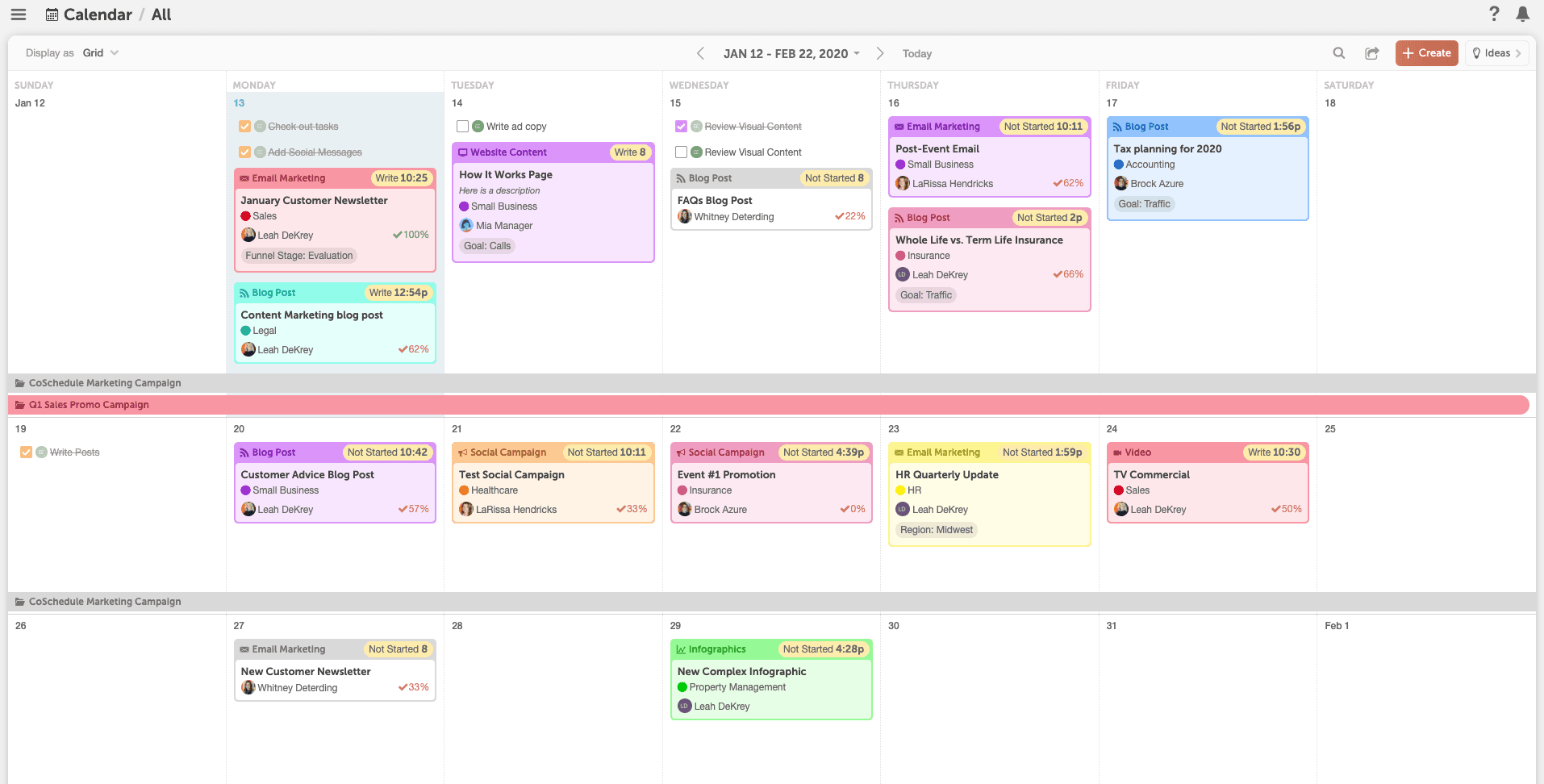
Spreadsheets: The free (but not necessarily easy) option. This option is a good place to start (but will require a lot of copying and pasting, and won’t allow for time-saving automation).
PDFs: The old-school pen-and-paper option. May work well for jotting down notes and planning a simple calendar at your desk.
SEO Software
If you create content and it doesn’t rank, does it even make a sound? (That might not be exactly how that metaphor works, but you get the point.)
What Can You Do With SEO Software?
If you’re going to spend time creating content, odds are you’ll have pieces you want ranking on search engines. This also means you’ll need the right tools to make sure your content is properly optimized so it’ll stand a chance at getting seen. Plus, you’ll need to measure your results to prove your SEO chops are actually driving results.
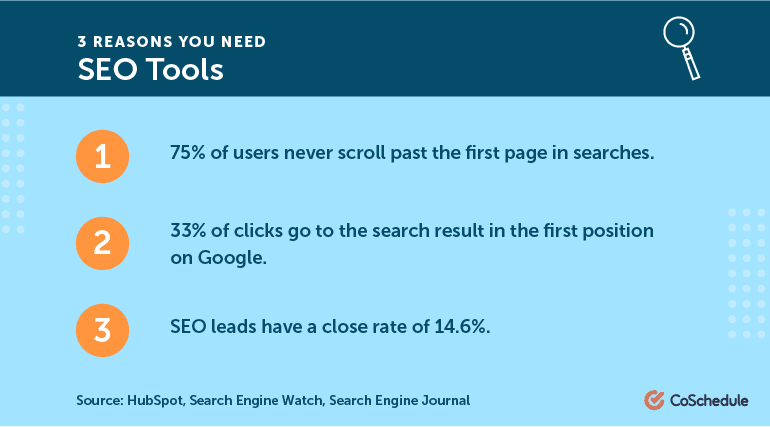
Which SEO Software Do You Need?
There are lots of options out there, but here are some we recommend.
Ahrefs: An SEO Swiss army knife with powerful keyword research, rank tracking, content analysis, technical auditing, and more features.
Moz: Another popular all-in-one SEO platform you’ve probably heard about.
Conductor: For large-scale enterprise companies, Conductor offers considerable power.
Can I Rank?: Wouldn’t it be nice if you could know a piece of content would rank before you published it? This tool helps tilt the odds in your favor.
Social Media Software
Creating social content at scale without automation or tools is nearly impossible. Fortunately, the market has more than met that need, with tons of different software options out there.
What Can You Do With Social Scheduling Software?
The short answer is exactly what you think, and a whole lot more.
Automate social posts. Instead of sitting on your computer 24/7.
Reshare top-performing posts. Great content should be seen more than once.
Measure results. Analyzing post performance is easier using one tool.
What Are Some Examples of Social Media Scheduling Software?
There are a lot out there. Here are some well-known options:
CoSchedule: Why have a stand-alone, single-function social media tool, when you can use the CoSchedule Social Organizer. The Social Organizer allows you to promote your content and plan your social schedule ALONGSIDE all your other marketing initiations… no more silos, no more messy social approvals. Just social media marketing that runs seamlessly with all your other marketing.
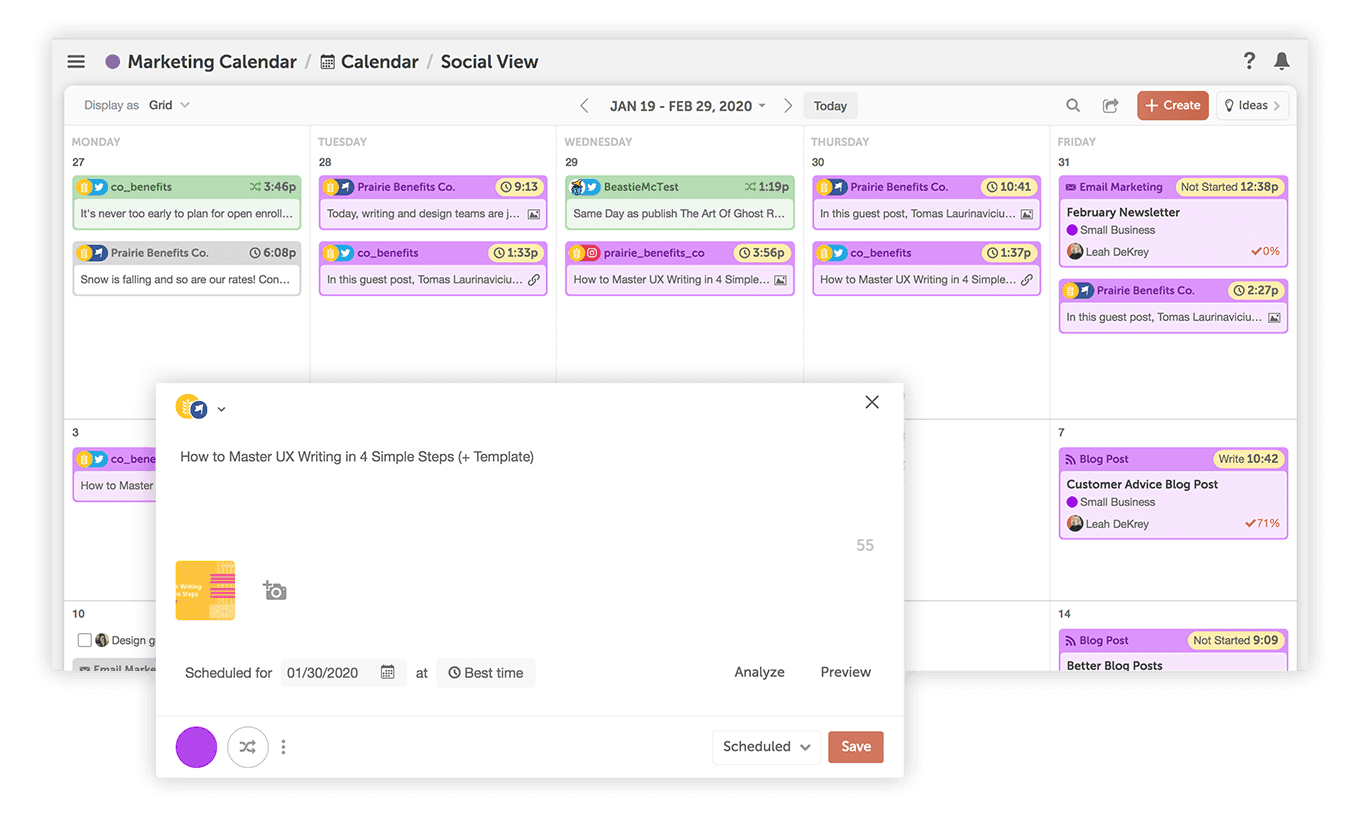
Hootsuite: Popular scheduling tool.
Buffer: Makes it easy to keep your social schedule full.
MeetEdgar: Automatically reshares posts.
Email Marketing Software
Once you’ve created content, you’ll need to promote it. Email is one of the best ways to do just that, delivering 4,000% ROI.
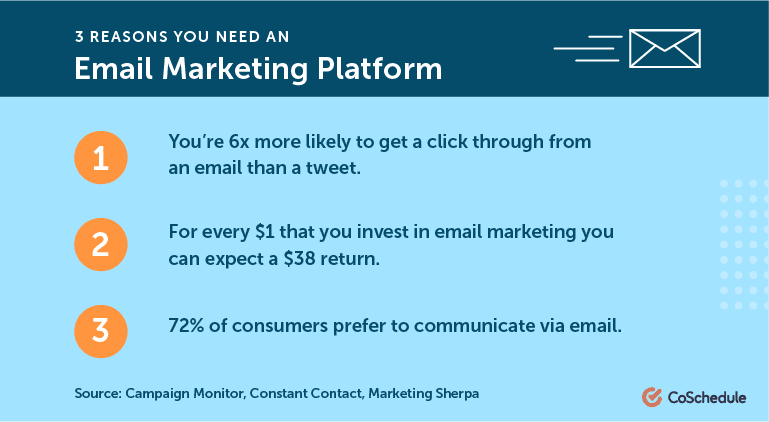
What Can You Do With Email Marketing Software?
There’s quite a bit you can do (beyond just sending emails). From creating email content to measuring the results, there’s no other way to do email marketing right.
Create designed emails easily. Hand-coding email newsletters can be extremely tedious.
A/B test headlines and content. Part of getting good at email marketing means split-testing different elements of newsletters to see what performs best over time.
Measure performance. Track open rates, CTR, bounce rates, and more.
Schedule emails in advance. Set it and forget it. Make sure to schedule emails at optimal times, too. Use the following starting points, and tweak from there:

What Is Some Popular Email Marketing Software?
Let’s take a look at some of the top platforms out there.
MailChimp: One of the most popular email tools out there, and for good reason. Their plans start at free and go all the way up to enterprise accounts.
Campaign Monitor: Powerful yet easy to use.
Active Campaign: Offers email marketing and integrated CRM and marketing automation features.
CoSchedule: Integrates with all of the services above so you can plan and send all your email marketing campaigns alongside the rest of your content, all on one platform.
Video Marketing Software
The popularity of video content has been on the rise for years. It’s not showing any signs of slowing down, either. That means your marketing team needs to be equipped with the right technology to produce video (even if you don’t have a full video marketing team at your disposal).
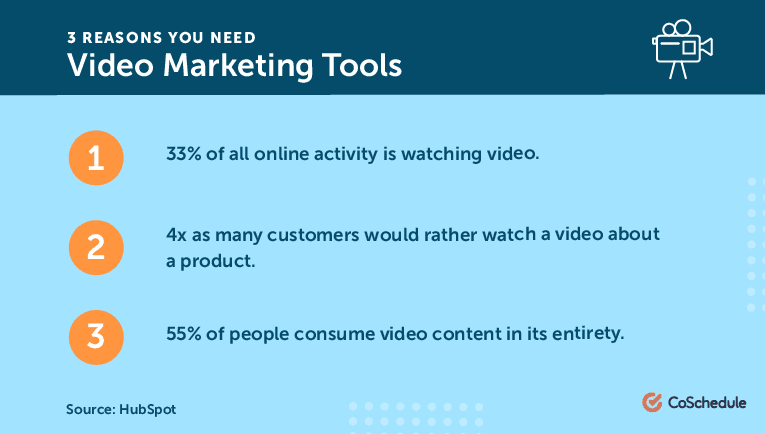
What Can You Do With Video Marketing Software?
There are tons of different tools out there, covering everything from video planning to production. We couldn’t possibly include all of them here, but let’s go over a handful that might be helpful.
Which Video Marketing Software Do You Need?
Here’s a small selection:
Celtx: This is a powerful and free platform for writing scripts and building storyboards.
YouTube: This is an obvious choice. But, what might not be obvious: it’s the world’s second largest search engine. If you’re doing video, your business needs to be on it.
Wistia: For hosting video you’ll embed on your website or blog, with full SEO benefits, Wistia is the way to go.
Content Marketing Project And Work Management Software
A typical content marketing campaign will include lots of moving parts. Keeping your team on track to get them all done might require some help. That’s where project management software comes in.
What Can You Do With Content Marketing Project Management Software?
The right tool can make streamlining project management easy. That means more productivity with less stress. Sounds awesome, right?
Reduce endless email strings. Managing communication in a purpose-built platform helps avoid losing things in inboxes.
Keep project timelines in order. Make sure every step in every project gets done on time.
Monitor team productivity. Know who’s getting what done, and when it’s getting done.
What Is Some Content Marketing Project Management Software?
There are a number of different project management apps out there that can work for marketers. However, most aren’t necessarily marketing-specific or designed with content needs in mind.
CoSchedule: The CoSchedule Work Organizer is the only project management platform made for marketing teams. It offers custom kanban views to track every project’s status; a task management dashboard to easily see who is working on what; task approvals so nothing gets published without the right people in the know; AND performance reporting so you can thwart missed deadlines and keep your team productive.
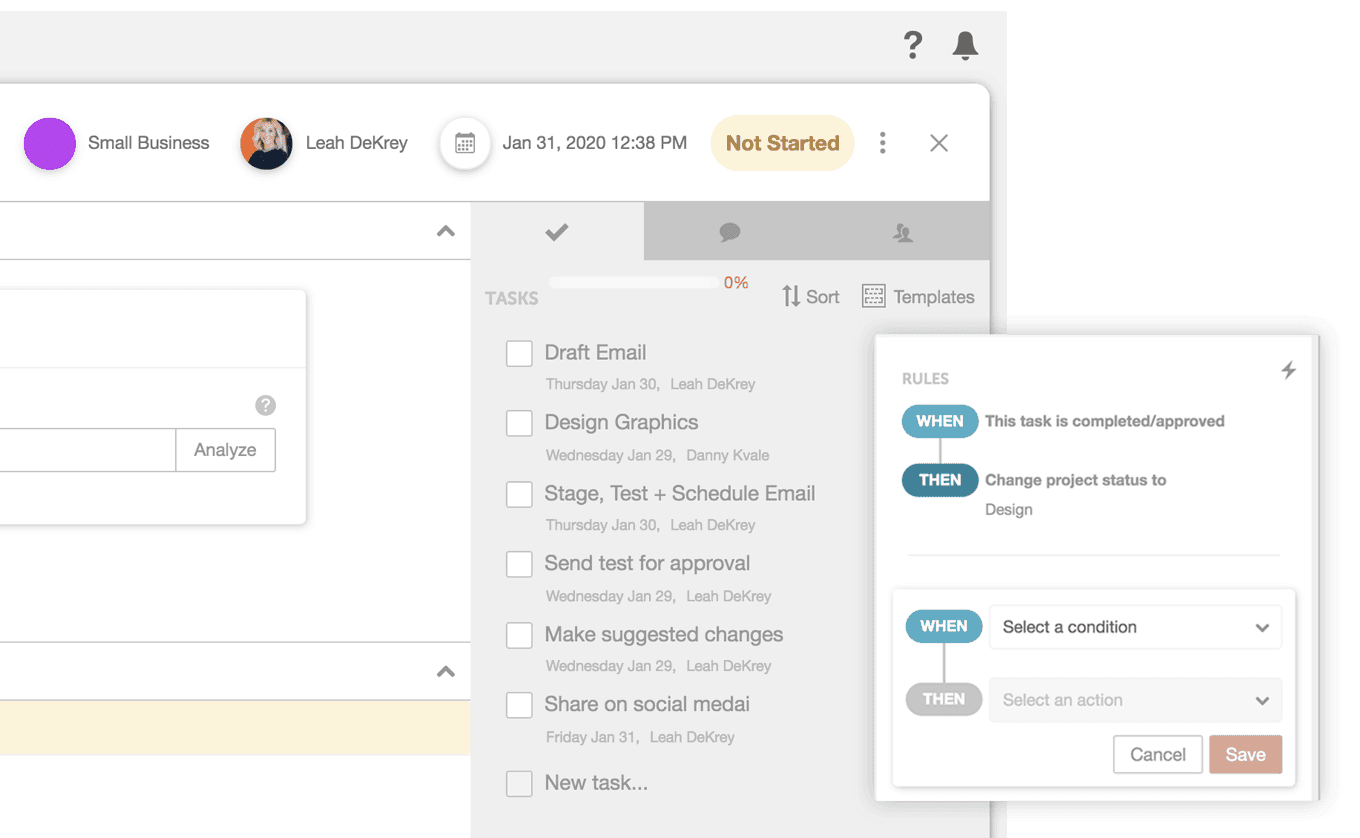
Trello: Popular kanban-style project management tool.
Wrike: Built for a wide variety of types of teams.
Asana: Helps organize teams and track results.
Basecamp: The first app ever built using Ruby On Rails (by a partner at the company).
Content Marketing Analytics Software
Measuring content marketing ROI can be a challenge. Having the right tools on your side, however, can help immensely. Fortunately, you have more and better options available today than ever before.
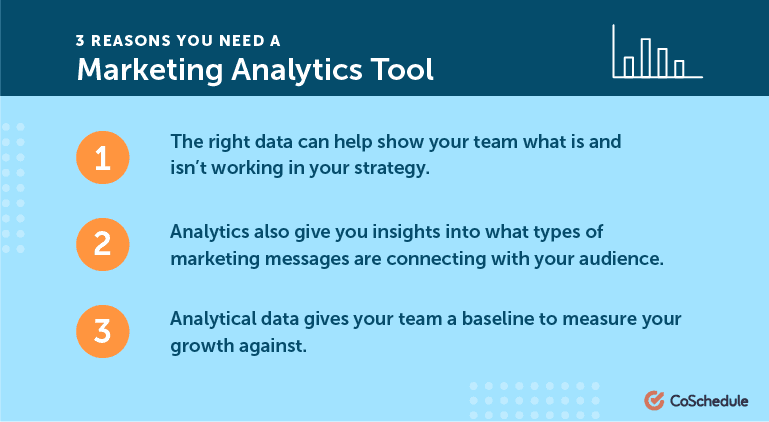
What Can You Do With Content Marketing Analytics?
Proving your work is driving results is essential if you’re going to say in business (and keep your job). Here are some specific things you can (and should) measure:
Blog and website analytics. On a basic level, this means stuff like traffic, bounce rate, and conversion rate. But, you can also gather data about your audience, track where traffic is coming from, identify where visitors are dropping off in your funnel, and more.
Social media analytics. Share counts, engagement rate, referral traffic, follower growth, and ROI are all basic items any marketer should be paying attention to.
Email marketing analytics. Subscriber growth, open rates, and click-through rates are common email marketing metrics to monitor.
So, this is all simple stuff. But, with more powerful platforms (like Kissmetrics), you can go deep down the rabbit hole of figuring out exactly how your content is influencing conversions.
Content Marketing Analytics Software to Consider
Here are some options to check out (including some we use at CoSchedule):
Google Analytics: This should almost go without saying. If you’re not a fan, though, Piwik is another alternative.
Google Search Console: In a better world, this would go without saying, too. But, Google Search Console is often overlooked. It’s a great resource for finding data about your website performance.
Kissmetrics: This is an advanced marketing analytics tool that, while it has a high learning curve, is worth getting your head around.
Raven Tools: Its roots are in the SEO world, but it also includes functionality for producing white-label reports that incorporate content and social media, too.
TapClicks: An all-in-one marketing and online advertising measurement and reporting platform.
3. What Are Content Marketing Tools?
Content marketing tools are simple, free, or low-cost single function apps. They focus on doing one job, like image creation, social media scheduling, or project management. These types of tools are never going to be all things to all people, and they’re okay with that.
Free Content Marketing Tools
Free doesn’t have to mean low-quality. You’ll need to spend some money to build a full marketing tool stack, but you might be surprised how far you can get without dropping a dime.
What Can I Do With Free Content Marketing Tools?
Quite a bit. While most of the tools we’ll cover in this post are paid (or have paid options), any marketer’s content toolbox will likely include some free gadgets for completing routine tasks.
What Are Some Free Content Marketing Tools to Consider?
Here’s a (by no means complete) list:
Headline Analyzer: Score every headline you write before publishing.
Email Subject Line Tester: Fine-tune subject lines to get more opens (before sending).
Social Message Optimizer: Optimize social media post copy to create posts that drive people to click.
Hubspot Blog Ideas Generator: Kickstart your inspiration and keep your content calendar full of ideas.
SERPs.com Free SEO Tools: These free keyword research and rank checking tools work well in a pinch (of if you don’t have immediate budget for a full SEO platform).
Spotibo SERP Preview Tool: See what your title tags and meta descriptions will look like in Google searches before hitting publish.
Percent Change Calculator: Need to measure week over week performance quickly? This free calculator is a major help for those of us who aren’t mathematicians.
Free Marketing Templates From CoSchedule: 86 templates for nearly every task imaginable:
Content Writing Tools
Marketers do a lot of writing. Having the right resources easily at hand can make producing high volumes of quality copy easier.
What Can You Do With Content Writing Tools?
We’re talking about more than just simple word processors here. Content writing tools are specialized to perform useful content creation tasks, from cleaning up content to guarding against copying other people’s work.
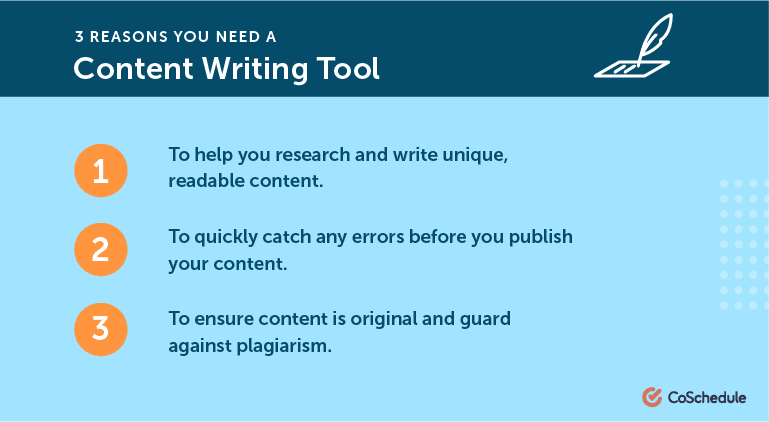
What Are Some Content Writing Tools to Consider?
Round out your toolbox with some of the following:
Grammarly: This plugin makes it easier to catch mistakes before you publish. It’s described as a free writing assistant.
Hemingway: This help shows how to make your writing more readable, to more people.
CoSchedule Content Organizer: CoSchedule’s content organizer includes a built-in text editor that can convert content directly into WordPress posts or downloadable HTML you can import into another CMS.
StackEdstackedit.ioit: A simple browser-based Markdown editor.
Unicheck: Plagiarism is bad news. For businesses, it could lead to a cease and desist order, or potentially even a lawsuit. Unicheck scans text to make sure its original.
Power Thesaurus: This crowd-sourced thesaurus can help you find alternate words people actually use, instead of just generic terms.
Content Design Tools
Poorly designed content is bad content. It doesn’t matter how strong any other element may be. But, you might not always have access to a designer. If that’s the case, these tools should help.
What Can You Do With These Content Design Tools?
If you’re not a designer by trade, these tools will help you create good-looking graphics without much trouble. From social images to full-on infographics, you might surprise yourself with what you can get done.
Tools like Canva offer templates to make creating simple graphics easy:

What Are Some Content Design Tools?
Canva: This image creation tool includes tons of templates to help you produce everything from flyers to social graphics to brochures and beyond. If it’s a piece of visual content, you can probably get it done in Canva.
Infogram: Similar to Canva, but dedicated to building infographics.
Piktochart: Another user-friendly tool focused on infographics, presentations, and print collateral.
GIMP: Can’t afford Photoshop? GIMP is a free and open-source alternative that offers almost as much power, and is useful if you’ve got enough design skill to be dangerous (or even if you just need to resize some graphics).
Vectr: If Illustrator is over your head but you still want to create vector graphics, this is the perfect option for you.
Content Marketing Dashboard Tools
Successful marketing is driven by data. But, in order to make use of data, you need a way to communicate it. Marketing dashboard tools make this possible, connecting multiple services into one hub to create visually appealing charts and real-time reports.
What Can I Do With a Content Marketing Dashboard?
Dashboards help simplify sharing data across an organization by pulling metrics into one place, and making them easy to understand.
Not everyone might know what you mean when you drop terms like “63% month-to-month increase in ROI” (just for example), but they will understand it’s a good thing when a chart or graph shows positive movement up and to the right. This is especially useful for demonstrating performance to clients or executives outside of marketing.
Here’s an example of one might look like, from Klipfolio:
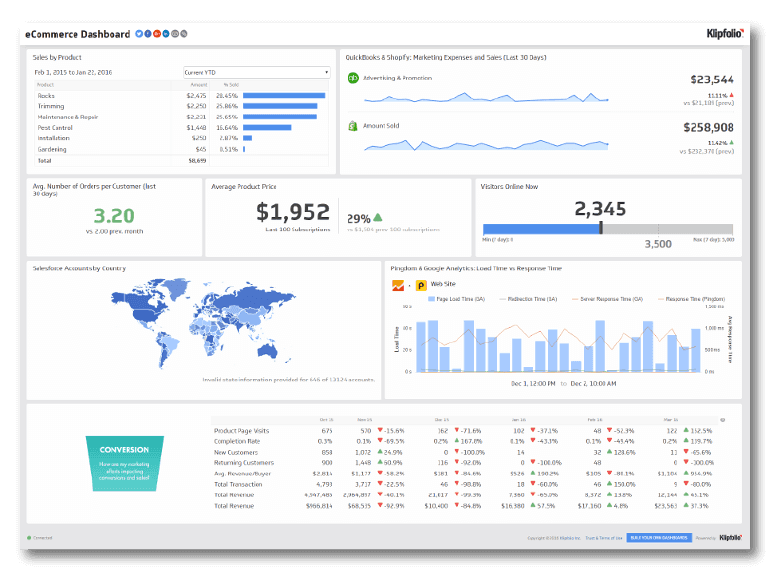
Which Dashboards Are Worth the Money?
There are few strong and decently affordable options out there:
Klipfolio: This powerful dashboard platform also includes templates that make it easy to set up reports that connect data from disparate tools.
Cyfe: Easy to use and connects tons of different services to one dashboard.
Grow: Another business intelligence and dashboarding tool that says it’s best for teams that rely on three or more data sources to make decisions.
Databox: This dashboard tool lets you track multiple types of performance data in real-time–all in one place.
Content Marketing Research Tools
The most authoritative content often starts with strong research. To get it done, you’ll need a little bit more than Google and Wikipedia.
What Can You Do With Content Marketing Research Tools?
Tons of stuff, like:
Surface trending topics. What are people talking about, both inside your industry, and out in the world at large?
Find influential writers. Who’s creating great content that you should consider partnering with, or getting to write something for you?
Spy on competitors. You can even scope out what your competition is up to, so you can zig when everyone else zags.
Which Content Marketing Research Tools Should You Try?
These are very different types of tools, but they’ll all help you do at least one thing: do better research, to create better content.
Feedly: This popular news reader is like an RSS feed on steroids.
Flipboard: Similar to Feedly, but with a magazine-style layout.
BuzzSumo: Super-powerful content research and analysis platform:
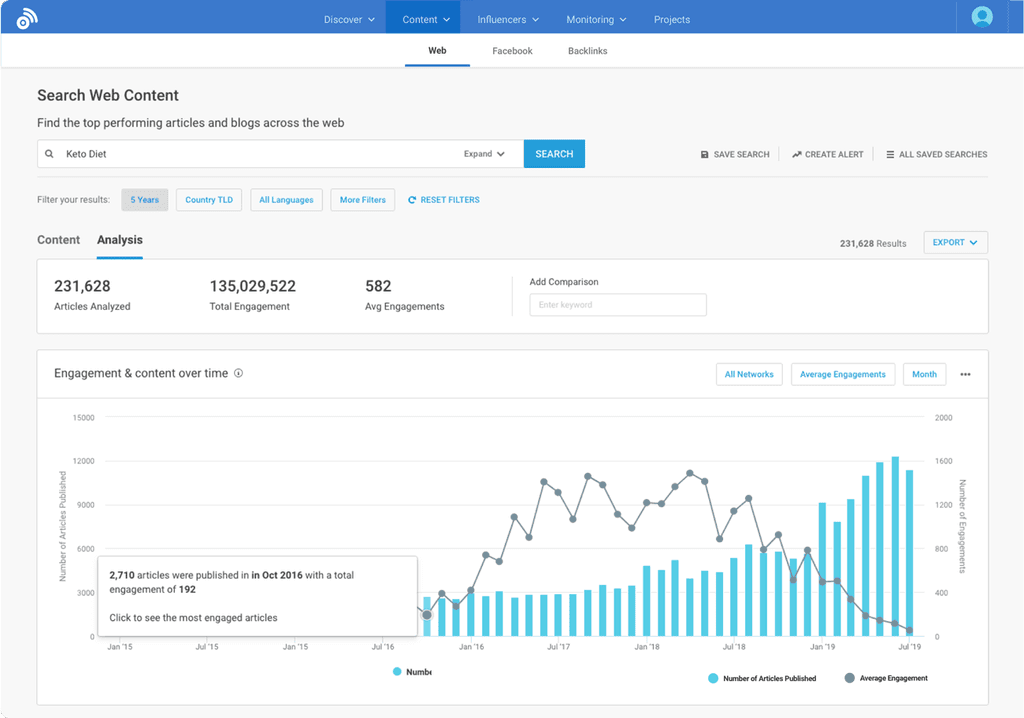
Content Curation Tools
To draw an audience, you need to plan, gather, and publish the best possible marketing content. A content curation tool can help you do just that.
What Can You Do With Content Curation Tools?
There’s a TON of information out there. Content curation tools are made to help you narrow your focus and choose the content that will be most valuable to your followers.
Here’s the full scoop on how to plan a curation schedule and get real benefits from it:

Which Content Curation Tools Should You Try?
Pocket: Groups together videos, articles, and other content in one place.
flockler: Creates a social hub for your content and brand mentions.
elink: Transforms online links into eye-catching curated content.
4. Recommending Reading For Content Marketers
We’ve covered tons of different software and tools you can use. But, in order to put them all to use, it helps to have the knowledge necessary to do the work.
In that spirit, here are some excellent learning resources we suggest checking out.
Read These Content Marketing Books
Youtility: How can marketers create content so good, people would pay for it? That’s exactly what Jay Baer covers in Youtility. This should be required reading for all content pros and marketers.
The 10X Marketing Formula: How did CoSchedule grow its own business and brand? Co-founder and CEO Garrett Moon gives marketers the exact philosophies and processes you can use to build sustainable and dramatic growth.
Everybody Writes: You’ll never go wrong as a marketer by improving your writing skills. Ann Handley’s go-to guide for crafting clear marketing copy and content is a great read, even if you never primarily considered yourself a writer before.
Practical Content Strategy and Marketing: Looking to build a content marketing strategy that’s actually actionable and results-oriented? Julia McCoy will show you how to get it done.
Spin Sucks: Gini Dietrich does a masterful job of showing marketers and PR pros how to communicate authentically to earn people’s trust. It’s an important skill for both PR practitioners and for content marketers alike.
Bookmark These Content Marketing Guides
Moz’s Beginner’s Guide to SEO: Every content marketer should know some things about SEO. This guide has long been one of the best places to start that education.
The Ultimate Guide to Create a Marketing Strategy That Will Skyrocket Your Results By 9,360%: Marketing strategies often fail because they’re overly complex and built on guesses. This guide shows exactly how to create a marketing strategy that works (based on actual experience and data to prove it). It also includes all the templates you need to put it all into practice.
Marketing Guides From Kissmetrics: There are tons of free guides here, covering everything from basic analytics to funnel optimization and beyond.
The Beginner’s Guide to Online Marketing: New to online marketing? Check out this guide from QuickSprout and lay the groundwork for marketing success.
The Ultimate Guide to Digital Marketing: A great resource for marketers of any experience level, this guide can help you strategize and optimize your digital marketing efforts.
Take These Content Marketing Courses
Copy School: Some of the best copywriting education you’ll get anywhere, courtesy of Joanna Wiebe and Copy Hackers.
CoSchedule Academy: Offers tons of different courses and certifications for content + social media marketing, and beyond.
Coursera: Get marketing education produced by real-world universities, without the high cost of tuition.
Chimp Essentials: Unlock MailChimp’s potential with video training from Paul Jarvis.
Simplilearn Masters Program: Learn all the ins and outs of digital marketing with this in-depth, 9-course program.
5. How To Convince Your Marketing Team To Adopt A New Platform
There’s more to building your marketing toolbox than simply selecting stuff you want, and getting the company credit card out. Once you’ve narrowed down solutions you know you need, you’ll likely be faced with two challenges:
Convincing your company to pay for it. If things seem to be going okay without the new tool, you’ll need to demonstrate how the new tool will improve your business.
Convincing your coworkers to use it. If the tool isn’t just for yourself, you’ll need to convince your team it’s better than what you’re using right now.
In both cases, understanding how marketing change management works can help you effectively build the case to upgrade your toolset.
This is something Nathan Ellering, who you may know as the Marketing Lead at CoSchedule, knows a lot about. In fact, he literally wrote the guide to getting past this roadblock (scope out the link in the paragraph above).
For our purposes here, though, we can summarize his key takeaways in three points:
Step 1: Show There’s a Need For A Platform Change
Odds are, something currently isn’t getting done right, or possibly even at all, because you don’t have the right tool to get the job done. Wouldn’t eliminating that struggle be better than banging your head against the wall?
Here’s how to do just that:
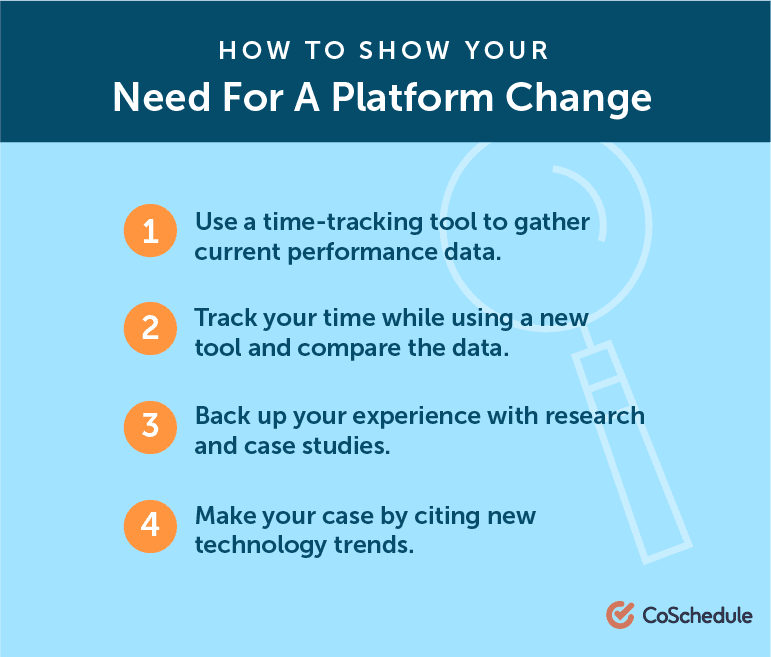
Gather data on current performance. Use a time-tracking tool like Toggl to measure how much time gets spent doing a certain task using your current process.
Then, start a trial with a new tool and track how much faster that task gets completed. Compare your results and other metrics as well.
Show examples. Back up first-hand experience with case studies and research from other companies. Most tool providers will have this type of content somewhere on their site.
Cite industry trends. Is the marketing industry moving in a direction that requires new technology to keep up? Find research and articles to support your case.
Step 2: Show How You’ll Thrive Once the Change Happens
It’s easier for people to see a better future for themselves when you, well, show them what it’d look like. It sounds simple, but having some actual evidence to demonstrate how a tool will make work better can be powerful for building a case.
Here’s a simple framework you can use to communicate this:
“When we do [X], we will achieve [Y].”
Framing your case this way indicates that achieve the goal is impossible without taking the stated action. The implication here is that the tool is necessary to complete that action, too.
So, how can you demonstrate this? Follow these two steps:
Visualize your current workflow without the tool you need.
Do the same exercise with the tool you’re after.
This can be as simple as opening up a document and listing out the steps to complete the task. Here’s an example of creating a whitepaper without CoSchedule (on the left) and with CoSchedule (on the right):
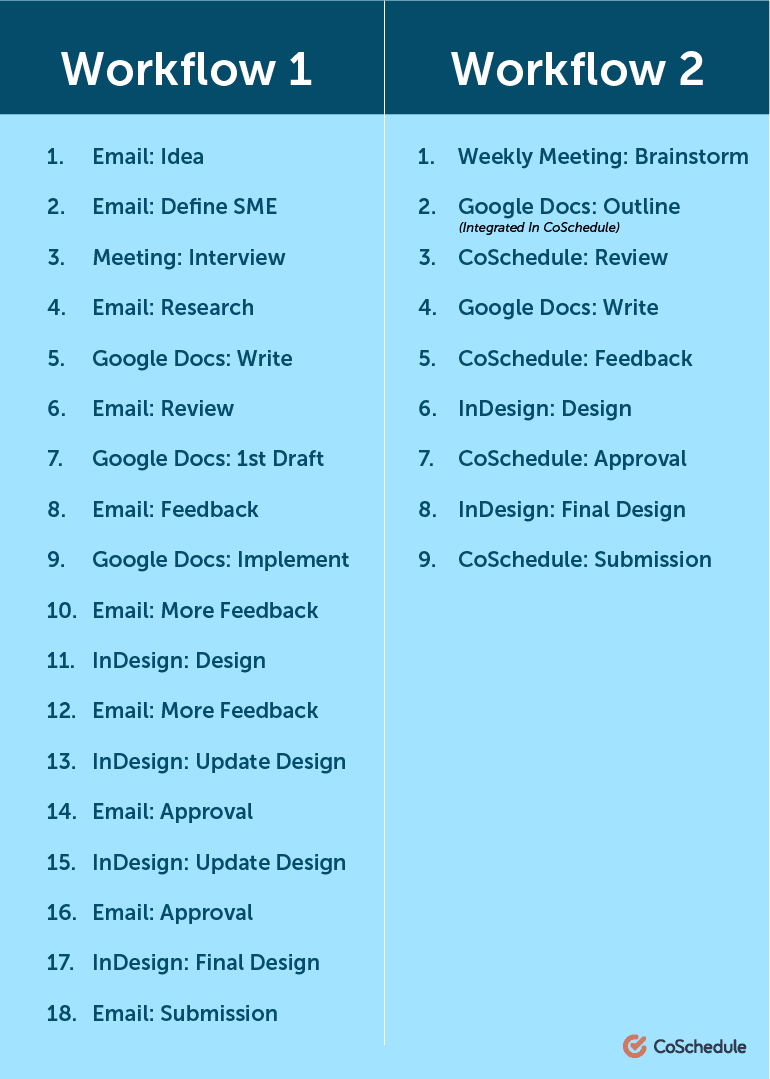
By doing this, you can help your team see exactly how their work will change (for the better) with the new tool.
Step 3: Show the Roadmap to Change
Tools only work as well as your ability to use them. And, obviously, positive change isn’t going to happen just because you spent money on a solution. Those are two pieces of resistance you can expect to hear, but can easily counter by showing you have a plan.
However, that pushback might not be without reason. Adopting new tools means adopting new workflows, and people are often resistant to change.
A good way to ease concerns that change will be hard is to show exactly what steps need to be taken to enact that change. You can do this by mapping out a timeline of steps that will be required to get the new tool up and running, and integrated into your team’s workflows:
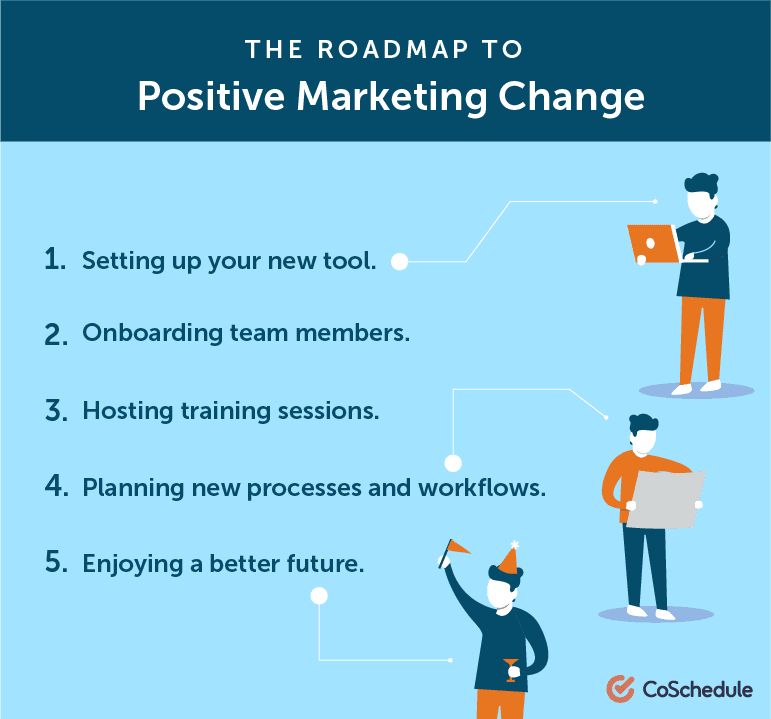
If you need an outside opinion to help build your case, software review directories like G2 Crowd make excellent resources to support your decision.
That’s a high-level summary of how to get folks on your side and be more successful with better software. For a more detailed breakdown, bookmark Nathan’s guide.
6. Get Organized With CoSchedule
CoSchedule is the industry’s leading content marketing platform.
But what does that mean, exactly? It means CoSchedule is the only content marketing software out there that can bring ALL of your marketing together in one place.
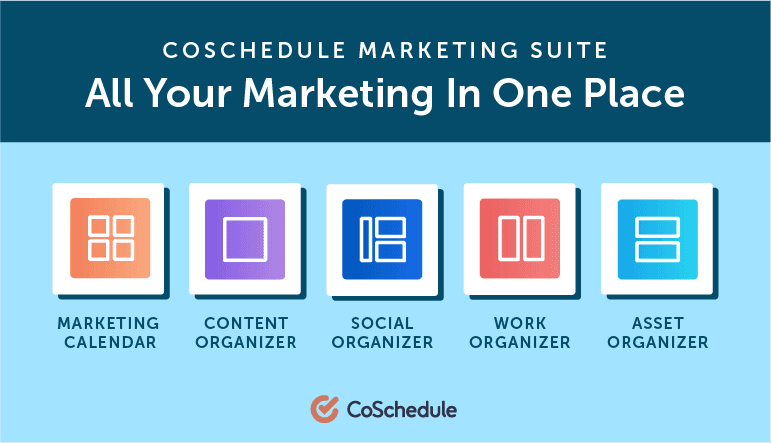
Marketing Calendar makes all of your team’s projects visible in one cross-functional calendar.
Content Organizer helps you create, schedule, and publish more quality content that converts.
Work Organizer automates workflows so you can speed up production and meet more deadlines.
Social Organizer helps you build an engaged following with automated features and templates.
Asset Organizer lets you easily store and share your digital content in a single, centralized library.
CoSchedule is your marketing department’s organizational hub to collaborate on every project and overcome makeshift marketing. It’s trusted by over 10,000 customers around the world. And it’s even earned a coveted place on Gartner’s Magic Quadrant for Content Marketing Platforms.
In short, it adds up to more success and less stress for your marketing team.
So, You Know You Need a New Content Marketing Platform or Tool…
…but you can’t convince your team to switch.
Or get your boss to open the checkbook.
Solve both of those problems with our free (and fun) Build Your Case For CoSchedule tool. We created it to help you prove exactly how your team could benefit from CoSchedule in just a few questions.

Recommended Reading:
How to Convince Your Marketing Team to Implement New Tools
Demo CoSchedule For Free
Curious about everything CoSchedule can do? Let us know and we’ll hop on a free demo call to see if it’s right for your marketing team.
This blog post was originally published on April 18, 2018. It was updated and republished on February 7, 2020.
The post 62 Of The Best Content Marketing Platforms, Software & Tools For Better Results appeared first on CoSchedule Blog.
Read more: coschedule.com
